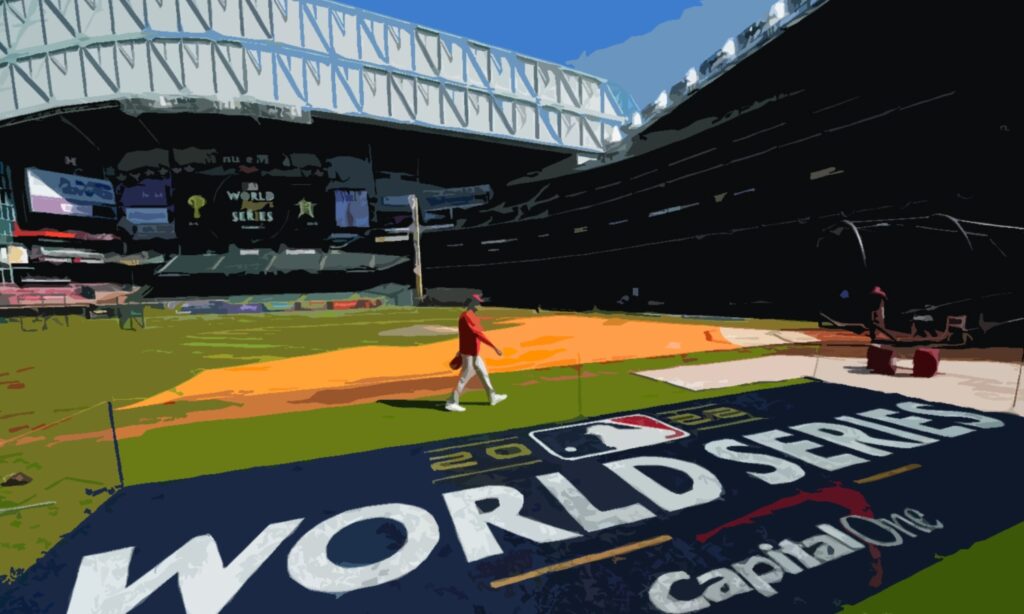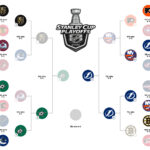It’s that time of year again. Your stress levels are high, palms are sweaty, and your heart is beating like a drum.
You know things are about to get serious as your team is in the MLB playoffs.
For some, they’ve known their team was set to make a championship run weeks in advance.
For others, they witnessed their team secure that last Wild Card spot at crunch time.
Now that the matchups are set, you might have asked yourself how did we get here and what should we expect?
Let’s start by answering the basic question.
How do MLB Playoffs Work?
There are twelve teams that qualify for the World Series. The top 2 teams of each division are given a first-round bye while the remaining eight play a best-of-three Wild Card round. The next three rounds are best-of-seven in which the first team to get 4 wins continue playing. The winner in the final round is crowned the World Series Champions.
In order to understand how teams qualify for the MLB playoffs, first let me explain how the league is structured.
The MLB is split into the American and National League, 15 teams in each.
Each league is made up of three divisions (6 total), with five teams per division:
AL East, AL Central, AL West.
NL East, NL Central and NL West
The division name gives you an idea as to where the teams could be located on the map.
There are 29 American teams and 1 Canadian located in Toronto.
At the end of the season, six teams in each league qualify for the playoffs. The top teams in each division are seeded 1, 2 and 3 in the league standings.
The three remaining spots are awarded to the teams with the best team record, regardless of their division.

How are teams seeded in the playoffs?
#1 Seed: Best League Record
#2 Seed: Second-best division winner
#3 Seed: Third-best division winner
#4 Seed: Best record among Wild Card teams
#5 Seed: Second-best record among Wild Card teams
#6 Seed: Third-best record among Wild Card teams
The top 2 seeds receive a first-round bye and advance automatically to the Division Series.
#3 seed faces-off against the #6 seed in a best-of-three series
#4 seed faces-off against the #5 seed in a best-of-three series
Both the #3 and #4 seed host all the games at their respective ballparks.
Note that it’s possible for the Third-best division winner has a worse off record than any or all of the Wild Card teams.
This does not play a role in the seeding, as they’ve secured their #3 spot as the division winner.
MLB Playoff Rounds Explained
With 12 teams now qualifying in the playoffs, the World Series is made up of 4 distinct rounds.
Below, I breakdown how each round works and which team is granted home field advantage at every stage.
MLB Wild Card Round
As stated earlier, the Wild Card round involves the bottom 4 teams in each league facing one another in a best-of-three series.
#3 seed faces-off against the #6 seed in a best-of-three series
#4 seed faces-off against the #5 seed in a best-of-three series
Both #3 and #4 seeds host the entire series at their ballpark.
That’s because the games are scheduled in three consecutive days as to not have the top seeds waiting too long to play during their bye.
The winner of each Wild Card series will move onto the Division series, while the losers are eliminated from the World Series.
Division Series
Regardless of who wins the Wild Card round, teams are not reseeded for the Division Series.
That is the #1 seed is guaranteed to face off against the winner between seeds 4 and 5.
Meanwhile, the #2 seed will play against the winner between seed 3 and 6.
This guarantees that the #1 seed will not possibly square off against another division winner in the Division Series.
The division series is a best-of-five, where the higher seed is granted home field advantage.
That is, the better seed is guaranteed to host 3 of the 5 games if the series goes the distance.
The playoff format is as follows for the home team: 2-2-1, which translates to 2 home games, 2 away and 1 home in that order.
First team to win three games will advance to the Championship Series. The loser is sent packing.
Championship Series
The Championship Series will determine which in NL and AL team represents their respective leagues in the finals.
Once again, the higher seed is awarded home field advantage. However, as of this round, the series is a best-of-seven.
The playoff format is as follows for the home team: 2-3-2, which translates to 2 home games, 3 away and 2 home in that order.
First team to win four games will advance to the World Series. The losers are eliminated from the post-season.
World Series Final
The World Series involves the last final two teams in a best-of-seven series.
The winner of this round will be crowned World Series champion and awarded the Commissioner's Trophy.
As with the Championship Series, the series format is 2-3-2, with the highest seed granted home field advantage.
Note again that 2-3-2 translates to 2 home games, 3 away and 2 home in that order.
MLB Past Playoff Structures
The MLB has tinkered with the World Series format several times since its inception.
Between 1901 and 1968, the top teams of each league would face-off in the World Series.
This despite each league consisting of up to 10 teams towards the latter years.
In 1969, the MLB added a 2nd round to the World Series, known today as the Championship Series.
This involved the top two teams in each league squaring off against one another.
Basically, four teams qualified for the post-season.
That changed again in 1994, when both the AL and NL expanded to 3 divisions.
Under this structure, all division leaders would advance to the playoffs along with a Wild Card team.
The reason was to grant a playoff berth to an additional team with the best record among the division runners-up.
This would add an additional round to the playoffs, known as the best-of-five Division Series.
Furthermore, the Wild Card team would play the divisional champion outside their division with the best record.
That is, the Wild Card team would never play against their own division leader in the first round.
As such, the other two teams would play one another.
The last change made before the current format lasted between 2011 and 2021, with the exception of the 2020 (due to COVID).
MLB expanded the playoffs to 10 teams, with the addition of a second Wild Card spot in each league.
The two Wild Card teams in each league would play one another in a one-game series.
The winner of that series would advance to the Division Series and face off against the division winner with the best record, regardless of if they were in the same division.
Extra Innings in Playoffs
As with the regular season, if the score is tied after 9 innings, the game will continue into extra innings until a winner is declared.
At this point, all extra-inning games will end at the bottom of the inning should either team break the tie.
For more details on this, make sure to read my post on How Many Innings in a Baseball Game?
Final Thoughts
To me, there’s nothing more exciting than a best-of-seven championship finale.
It leaves no question as to which team deserves the title.
Both teams are guaranteed at least four games to swing the momentum or make an example of their rival.
Keep in mind that Major League Baseball plays the most games compared to any other professional sports leagues.
So, when it comes to a close, player emotions run extremely high.
There is no worse feeling than competing in over 200 games on the season and losing in the World Series final.
I don’t care how much players get paid; a World Series loss will sting, possibly for life.
You were that close, without ever knowing if you can make a run at it again.
But, as with every rivalry, there must be a winner and a loser.
Kudos to both teams and their players who gave it all they got.






